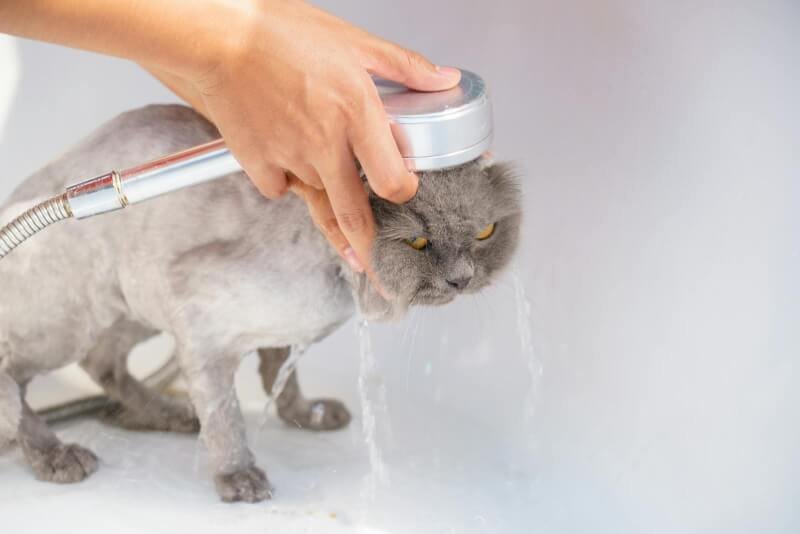If you’ve ever found yourself wondering about the proper way to bathe a cat, you’re not alone. As cat owners, we want to ensure that our feline friends are clean and well-groomed, but the task of bathing them can often seem daunting. In this article, we’ll explore some tips and tricks to make the bathing experience as stress-free as possible for both you and your furry companion. From choosing the right shampoo to creating a calm and safe environment, we’ll cover everything you need to know to give your cat a refreshing and enjoyable bathing experience.
Choosing the Right Time and Place
Picking the Right Time
When it comes to bathing your cat, timing is everything. Choose a time when your cat is generally calm and relaxed, such as after playtime or a nap. Avoid bathing her when she is agitated or hungry, as this can make the whole process more challenging. By picking the right time, you can ensure a smoother and more pleasant experience for both you and your feline friend.
Creating a Safe and Calm Environment
Before you start the bathing process, it’s important to create a safe and calm environment for your cat. Choose a quiet room where you can shut the door to prevent any escapes. Remove any items that could potentially scare or harm your cat, such as loud noises or sharp objects. Creating a peaceful and secure space will help your cat feel more at ease during the bath.
Gathering the Necessary Supplies
Choosing the Right Shampoo
Selecting the right shampoo is crucial for a successful cat bath. Look for a cat-specific shampoo that is mild and gentle on the skin. Avoid using human shampoos or products that contain harsh chemicals, as they can irritate your cat’s sensitive skin. Consult with your veterinarian to determine the best shampoo for your cat’s specific needs.
Getting a Cat-friendly Brush
Before the bath, it’s a good idea to brush your cat’s coat to remove any loose fur and tangles. Investing in a cat-friendly brush with soft bristles will help keep your cat’s coat in top condition and prevent matting. Brushing beforehand can also make the bathing process more manageable and help avoid further tangling while wet.
Preparing Towels and a Hairdryer
Having a stack of soft towels ready before the bath is essential for drying your cat afterward. Opt for towels that are absorbent, but not too rough on your cat’s delicate skin. Additionally, keep a hairdryer on hand to gently blow-dry your cat’s coat if necessary. Ensure the hairdryer is on the lowest heat setting and maintain a safe distance to prevent any discomfort or burns.
Selecting a Non-slip Mat
To ensure your cat feels secure throughout the bath, place a non-slip mat or towel in the bottom of the sink or tub. This will help prevent any slipping or sliding and create a stable surface for your cat to stand on. A non-slip mat will make the bathing experience more comfortable for your cat and provide you with better control during the process.

Pre-bath Preparations
Trimming Your Cat’s Nails
Before bathing your cat, it’s important to trim her nails. This will help minimize the risk of scratches and make the whole experience more pleasant for both of you. Use cat-specific nail clippers and be careful not to cut too close to the quick. If you’re unsure about nail trimming, consult with your veterinarian or a professional groomer for guidance.
Brushing Their Coat
Gently brush your cat’s coat before the bath to remove any loose fur, debris, or tangles. This will not only make the bathing process easier but also help prevent matting. Pay special attention to areas that are prone to tangling, such as the belly and behind the ears. Brushing beforehand will also help distribute natural oils, keeping your cat’s coat healthy and shiny.
Placing Cotton Balls in Their Ears
To protect your cat’s ears from getting water inside, place a small, soft cotton ball in each ear. This will help prevent any discomfort or potential ear infections. Be sure to insert the cotton balls gently and securely, ensuring they won’t fall out during the bath. Remember to remove them afterward to prevent any moisture buildup.
The Bathing Process
Testing the Water Temperature
Before wetting your cat, it is crucial to check the water temperature. Cats are sensitive to heat, so make sure the water is lukewarm, neither too hot nor too cold. You can test the water by running it over your wrist or using a bath thermometer. Ensuring the right water temperature will help keep your cat calm and comfortable during the bath.
Putting on Protective Clothing
Just like your cat needs protection during the bath, so do you. Put on some old, comfortable clothes that you don’t mind getting wet or dirty. Consider wearing long sleeves and pants to protect your skin from scratches. Additionally, wearing gloves can provide an extra layer of protection against potential bites or scratches.
Wetting Your Cat Gradually
To ease your cat into the bathing process, start by slowly wetting her body with a handheld sprayer or a cup of water. Avoid pouring water directly on her head, as cats generally dislike water on their faces. Begin from the back and work your way down, using a gentle and calm approach. Gradually wetting your cat will help her adjust to the water and minimize any stress or resistance.
Applying the Shampoo
Once your cat is wet, it’s time to apply the shampoo. Dilute the recommended amount of cat shampoo in a container of water, making sure to read and follow the instructions on the bottle. Gently massage the shampoo mixture onto your cat’s coat, focusing on areas that may be particularly dirty or greasy. Be mindful of avoiding contact with your cat’s face and ears.
Thoroughly Rinsing the Coat
After shampooing, it’s crucial to rinse your cat’s coat thoroughly to remove all traces of shampoo. Use the handheld sprayer or a cup of clean water to saturate your cat’s fur and ensure no residue is left behind. Make sure the water is lukewarm throughout the rinsing process to maintain your cat’s comfort. Proper rinsing is essential to prevent skin irritation or itching.
Avoiding the Face and Ears
When bathing your cat, it’s important to avoid getting water on her face and ears. Most cats are not fond of having water on their faces, and it can lead to agitation or stress. Instead, use a damp cloth or cat-approved wipes to clean her face and ears separately. Be gentle and take your time to ensure a comfortable experience for your feline companion.
Drying Your Cat with Towels
Once you have finished rinsing, gently lift your cat out of the water and place her on a soft towel. Use another towel to start drying her off, patting the fur in a gentle, blotting motion. Avoid vigorous rubbing, as it can cause unnecessary stress or discomfort. If needed, you can also use a hairdryer on the lowest heat setting, maintaining a safe distance from your cat to avoid overheating.

Dealing with Challenges
Handling an Agitated Cat
Despite your best efforts, your cat may become agitated or stressed during the bath. Stay calm and take a break if necessary. Use reassuring words and a gentle touch to help soothe your cat. If your cat becomes too anxious or unmanageable, consider seeking the assistance of a professional groomer with experience in handling difficult cats.
Dealing with Scratching and Biting
Cats may resort to scratching or biting when they feel threatened or scared. To minimize the risk of scratches, consider using gloves and long sleeves for added protection. If your cat starts scratching or biting, avoid pulling away forcefully, as this may escalate the situation. Instead, try distracting her with treats or toys, or gently redirect her attention to something else.
Using a Calming Technique
If your cat becomes anxious or fearful during the bath, you can try using a calming technique to help ease her stress. Some options include playing soft classical music, using pheromone sprays, or providing treats with calming ingredients. These techniques can help create a more relaxing atmosphere and make the bathing experience more enjoyable for your cat.
Post-bath Care
Drying Your Cat’s Coat Properly
After your cat is dry, it’s important to ensure her coat is completely dry to prevent any skin infections or discomfort. Use a fresh towel to pat her fur gently, absorbing any remaining moisture. Allow your cat to air dry in a warm and comfortable environment, ensuring there are no drafts. This will help keep her coat healthy and reduce the risk of any post-bath chills.
Brushing and Grooming
Once your cat’s coat is dry, take the time to brush and groom her. This will help remove any remaining tangles, distribute natural oils, and keep her coat looking its best. Use a cat-friendly brush and be gentle to avoid any discomfort. Regular brushing and grooming sessions can also help you bond with your cat and provide an opportunity for you to check for any skin or coat issues.
Rewarding Your Cat
After a successful bath, don’t forget to reward your cat for her cooperation and good behavior. Offer her treats, praise, or a favorite toy as a positive reinforcement. This will create a positive association with the bathing experience and make future baths more enjoyable for your cat.
Special Considerations for Long-haired Cats
Extra Brushing and Detangling
For long-haired cats, the bathing process may require some additional steps. Before bathing, spend extra time brushing and detangling her coat to remove any mats or knots. Using a wide-toothed comb or a specialized detangling tool can help make the process easier. Remember to be gentle and patient, as long-haired cats’ coats can be delicate and prone to tangling.
Using a Conditioner
Long-haired cats can benefit from using a conditioner during the bathing process. Choose a cat-specific conditioner that is designed to moisturize and soften the fur. Dilute the conditioner in water and apply it to your cat’s coat, focusing on the ends and any areas that are particularly dry or tangled. Conditioner can help keep your cat’s hair shiny, manageable, and free of mats.
Trimming Their Fur
To maintain a long-haired cat’s coat, regular trimming may be necessary. Trimming can help prevent excessive matting and keep the coat in a more manageable condition. If you’re unsure about how to trim your cat’s fur, consult with a professional groomer or your veterinarian for guidance.
When to Seek Professional Help
Medical Conditions or Injuries
If your cat has any underlying medical conditions or injuries, it’s best to seek professional help for bathing. Your veterinarian can provide guidance on how to safely bathe your cat while considering her specific health needs. They may also recommend medicated shampoos or alternative bathing methods to accommodate any existing conditions.
Extreme Fear or Anxiety
If your cat becomes extremely fearful or anxious during baths, it may be challenging for you to handle the situation effectively. In such cases, it’s advisable to consult a professional groomer or an animal behaviorist who has experience working with anxious cats. They can provide specialized techniques and advice to ensure the safety and well-being of both you and your cat.
Excessive Aggression or Difficulty in Handling
Dealing with an aggressive or difficult-to-handle cat during baths can be overwhelming and potentially dangerous. If your cat consistently displays aggression or poses a risk to herself or others, it’s important to seek professional help. A professional can evaluate your cat’s behavior, provide appropriate training or behavior modification techniques, and offer guidance on how to manage challenging bathing situations.
Final Tips for a Successful Bath
Remaining Calm and Patient
One of the most important factors in a successful cat bath is your own attitude and approach. Remember to stay calm and patient throughout the entire process. Cats can sense your emotions, so maintaining a relaxed and positive demeanor will help keep your cat at ease and increase the likelihood of a successful bath.
Preventing Future Bathing Challenges
To prevent future challenges during bath time, it’s important to gradually introduce your cat to the concept of bathing from an early age. Make bath time a positive experience by offering treats, praise, or playtime afterward. Additionally, establish a routine by scheduling baths at regular intervals. Consistency and positive reinforcement will help your cat become more accustomed to baths and make the process smoother over time.
In conclusion, knowing the proper way to bathe your cat is essential for maintaining her hygiene and overall well-being. By choosing the right time and place, gathering the necessary supplies, and following a step-by-step process, you can ensure a successful and stress-free bathing experience for both you and your feline companion. Remember to remain calm, be patient, and always prioritize your cat’s comfort and safety. With proper preparation, gentle handling, and a positive approach, bathing can become a bonding activity that strengthens your relationship with your beloved cat.


